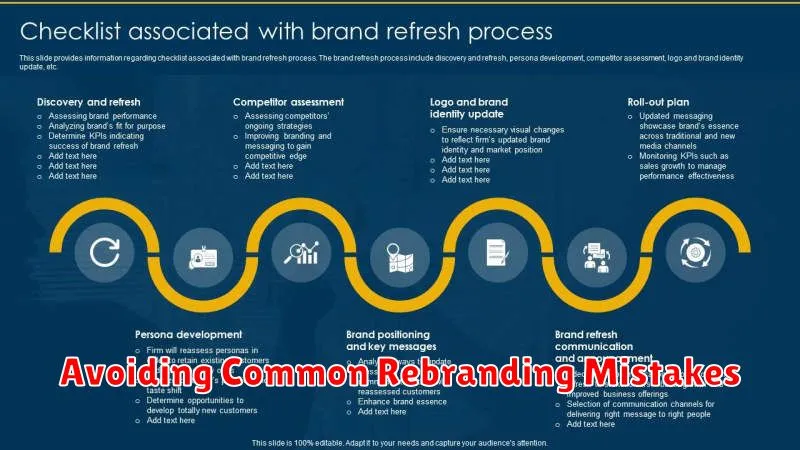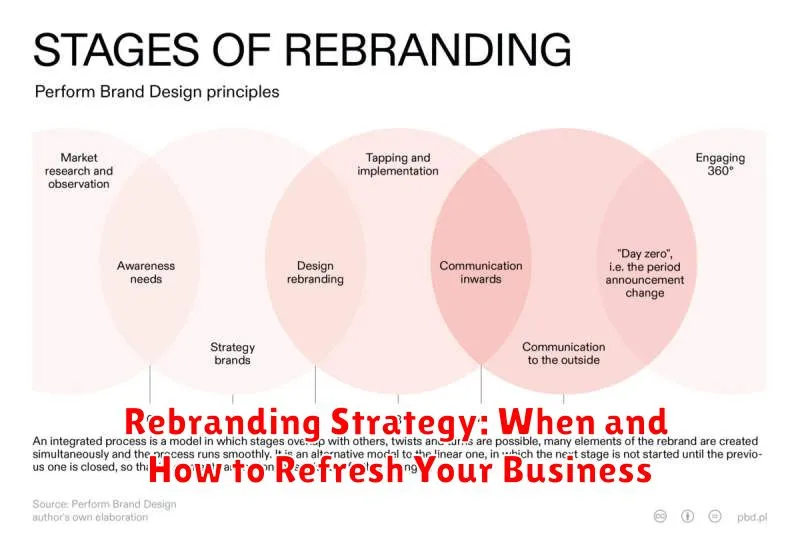In today’s dynamic market, a rebranding strategy can be the key to revitalizing your business and achieving sustainable growth. Whether your company is facing declining sales, shifting demographics, or simply needs a refresh, understanding when and how to rebrand is crucial. This article will delve into the essential elements of a successful rebranding strategy, providing actionable insights to help you determine if it’s the right time for a change and guide you through the process of refreshing your business for optimal impact.
A rebrand is more than just a new logo or tagline; it’s a fundamental shift in how your business is perceived by the market. From reevaluating your brand identity and brand messaging to revamping your marketing strategy, a well-executed rebranding strategy can breathe new life into your company, attract new customers, and strengthen loyalty among existing ones. This comprehensive guide will explore the signs that indicate a need for rebranding, the critical steps involved in the process, and the best practices for ensuring a successful brand refresh.
Signs It’s Time to Rebrand
Recognizing when your brand needs a refresh is crucial for sustained success. Several key indicators can signal that it’s time to consider a rebrand. A decline in market share or stagnant growth often suggests your brand is losing relevance. Negative customer feedback or a damaged reputation requires immediate attention and often necessitates a rebrand to rebuild trust.
Internal shifts, such as a merger or acquisition, or a significant change in your target audience, also warrant a rebrand to reflect the evolved business. Finally, an outdated brand identity that no longer aligns with current market trends can make your business appear irrelevant. Addressing these issues proactively through rebranding can revitalize your image and propel future growth.
Clarifying Your New Brand Vision
A crucial step in rebranding is clarifying your new brand vision. This involves defining where you want your brand to be in the future and what you want it to represent. This vision acts as a north star, guiding all rebranding decisions.
Start by revisiting your mission and values. Have they evolved? Do they still accurately reflect your business? Consider your target audience. Have their needs or preferences changed? Analyzing these factors will help you shape a vision that resonates with both your internal team and your external customers.
Your new brand vision should be concise, inspiring, and aspirational. It should clearly articulate the unique value your brand offers and the impact you aim to make. This clarity ensures everyone is aligned and working towards the same goal during the rebranding process.
Customer Research and Brand Perception

Understanding your customer base and their perception of your brand is crucial for a successful rebranding. Customer research provides valuable insights into their needs, preferences, and pain points. This data helps inform the rebranding process and ensures the new brand resonates with the target audience.
Methods for gauging brand perception include surveys, focus groups, and social media analytics. Analyze existing customer data and gather new information to form a comprehensive understanding of how your brand is currently perceived. Identify both positive and negative aspects. This analysis will highlight areas for improvement and inform the direction of the rebrand.
Redesigning Visual Identity
A critical aspect of rebranding involves redesigning your visual identity. This encompasses all the visual elements representing your brand, creating a cohesive and recognizable image.
Key elements of visual identity include the logo, color palette, typography, and imagery. Updating these elements can signal a shift in brand direction, appealing to a broader audience or reinforcing a renewed brand message.
Consider whether your current visual identity aligns with your evolving brand values and target market. A redesign doesn’t necessarily mean a complete overhaul; sometimes, subtle refinements can make a significant impact.
Messaging and Tone Adjustments
A rebrand often necessitates adjusting your messaging and tone of voice. This is crucial for aligning with your new brand identity. Consider whether your current messaging still resonates with your target audience and accurately reflects your evolved values and offerings.
Key questions to consider include: Does your messaging feel outdated? Does it accurately represent your brand’s personality? Is it consistent across all platforms? A refresh may involve simplifying your language, adopting a more modern tone, or highlighting new aspects of your business.
Website and Social Media Rollout
A successful rebrand requires a coordinated launch across all digital platforms. Your website and social media channels are often the first points of contact for customers, so they must reflect your new brand identity consistently.
Website Launch: Ensure your website is updated with the new branding elements, including logo, color palette, typography, and messaging. Thoroughly test the site’s functionality before the official launch to avoid technical glitches and ensure a seamless user experience.
Social Media Unveiling: Update your social media profiles with the new brand assets. Consider a coordinated launch across all platforms to maximize impact. Prepare engaging content, such as a brand story video or behind-the-scenes look at the rebranding process, to generate excitement and build brand awareness.
Internal Communication and Team Buy-In
Internal communication is crucial for a successful rebrand. Before launching externally, ensure your team understands the “why,” “what,” and “how” of the rebranding process. This fosters a sense of ownership and allows them to become effective brand ambassadors.
Clearly communicate the reasons behind the rebrand, the new brand values, and the visual changes. Encourage questions and feedback. Team buy-in ensures a consistent brand message across all internal and external communications.
A well-informed team can confidently answer customer questions and champion the change, leading to a smoother transition and greater acceptance of the new brand identity.
Timing and Budget Considerations
Timing is crucial for a successful rebrand. Consider factors like market trends, competitive activity, and internal milestones. A rebrand during periods of growth or expansion can amplify positive momentum. Conversely, rebranding during a crisis might appear reactive or inauthentic.
Budget allocation directly impacts the scope of the rebrand. Define a realistic budget early in the process. Consider expenses associated with new visual assets (logo, website, etc.), marketing materials, and internal communications. A phased approach can help manage costs by prioritizing essential elements.
Tracking the Impact of Rebranding
After launching your rebrand, meticulous tracking is crucial to understand its effectiveness. This involves monitoring key metrics before, during, and after the rebranding initiative.
Focus on analyzing website traffic, social media engagement, and sales conversions. Observe changes in brand awareness and sentiment through surveys and social listening.
Key Performance Indicators (KPIs) should be aligned with your rebranding objectives. For example, if a goal was to increase brand awareness, track metrics like social media impressions and website visits. If increasing sales was a primary objective, closely monitor conversion rates and revenue.
Avoiding Common Rebranding Mistakes

Rebranding can be a powerful tool for growth, but missteps can hinder progress. Clearly define your objectives before starting. A rebrand isn’t just about a new logo; it’s about aligning your brand with your business goals.
Don’t neglect research. Understanding your target audience and competitors is crucial for a successful rebrand. Ignoring market research can lead to a disconnect between your brand and its intended audience.
Rushing the process can result in a poorly executed rebrand. Take the time to develop a comprehensive strategy and ensure consistent implementation across all platforms.

